新人教版八年级下册英语教案(全册)
(完整版)英语人教版八年级下册英语教学设计
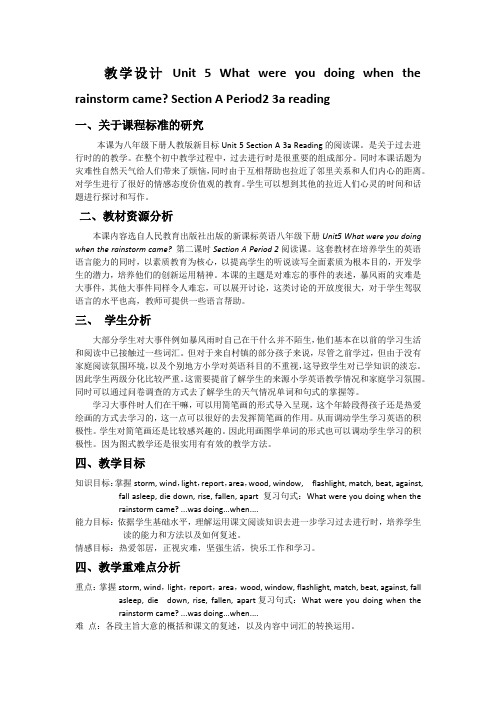
教学设计Unit 5 What were you doing when the rainstorm came? Section A Period2 3a reading一、关于课程标准的研究本课为八年级下册人教版新目标Unit 5 Section A 3a Reading的阅读课。
是关于过去进行时的的教学。
在整个初中教学过程中,过去进行时是很重要的组成部分。
同时本课话题为灾难性自然天气给人们带来了烦恼,同时由于互相帮助也拉近了邻里关系和人们内心的距离。
对学生进行了很好的情感态度价值观的教育。
学生可以想到其他的拉近人们心灵的时间和话题进行探讨和写作。
二、教材资源分析本课内容选自人民教育出版社出版的新课标英语八年级下册Unit5 What were you doing when the rainstorm came?第二课时Section A Period 2阅读课。
这套教材在培养学生的英语语言能力的同时,以素质教育为核心,以提高学生的听说读写全面素质为根本目的,开发学生的潜力,培养他们的创新运用精神。
本课的主题是对难忘的事件的表述,暴风雨的灾难是大事件,其他大事件同样令人难忘,可以展开讨论,这类讨论的开放度很大,对于学生驾驭语言的水平也高,教师可提供一些语言帮助。
三、学生分析大部分学生对大事件例如暴风雨时自己在干什么并不陌生,他们基本在以前的学习生活和阅读中已接触过一些词汇。
但对于来自村镇的部分孩子来说,尽管之前学过,但由于没有家庭阅读氛围环境,以及个别地方小学对英语科目的不重视,这导致学生对已学知识的淡忘。
因此学生两级分化比较严重。
这需要提前了解学生的来源小学英语教学情况和家庭学习氛围。
同时可以通过问卷调查的方式去了解学生的天气情况单词和句式的掌握等。
学习大事件时人们在干嘛,可以用简笔画的形式导入呈现,这个年龄段得孩子还是热爱绘画的方式去学习的,这一点可以很好的去发挥简笔画的作用。
从而调动学生学习英语的积极性。
八下全册英语电子教案人教版
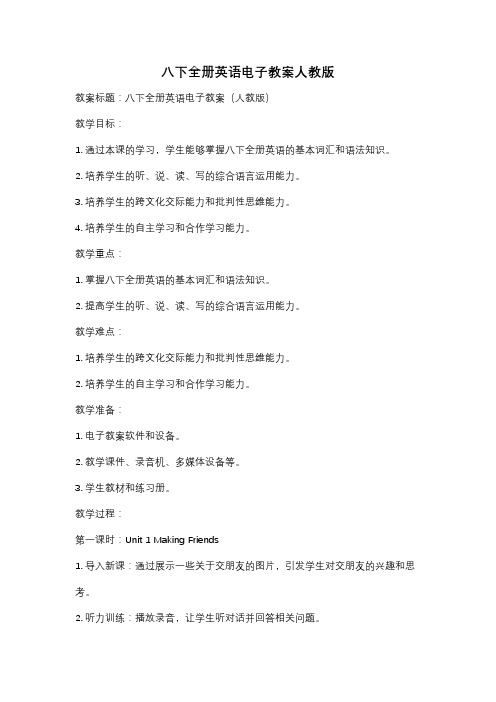
八下全册英语电子教案人教版教案标题:八下全册英语电子教案(人教版)教学目标:1. 通过本课的学习,学生能够掌握八下全册英语的基本词汇和语法知识。
2. 培养学生的听、说、读、写的综合语言运用能力。
3. 培养学生的跨文化交际能力和批判性思维能力。
4. 培养学生的自主学习和合作学习能力。
教学重点:1. 掌握八下全册英语的基本词汇和语法知识。
2. 提高学生的听、说、读、写的综合语言运用能力。
教学难点:1. 培养学生的跨文化交际能力和批判性思维能力。
2. 培养学生的自主学习和合作学习能力。
教学准备:1. 电子教案软件和设备。
2. 教学课件、录音机、多媒体设备等。
3. 学生教材和练习册。
教学过程:第一课时:Unit 1 Making Friends1. 导入新课:通过展示一些关于交朋友的图片,引发学生对交朋友的兴趣和思考。
2. 听力训练:播放录音,让学生听对话并回答相关问题。
3. 语言点讲解:介绍本单元的重点词汇和语法知识,如常见的交际用语、形容词的比较级和最高级等。
4. 听力训练:再次播放录音,让学生进行听力练习,并完成相关练习题。
5. 阅读训练:学生阅读课文并回答问题,加深对课文内容的理解。
6. 语言运用:学生进行口语练习,模仿课文中的对话,练习使用新学的交际用语。
7. 作业布置:要求学生完成课后练习册中的相关练习题。
第二课时:Unit 2 Growing Pains1. 复习导入:通过回顾上节课的内容,帮助学生温习所学的词汇和语法知识。
2. 听力训练:播放录音,让学生听对话并回答相关问题。
3. 语言点讲解:介绍本单元的重点词汇和语法知识,如情态动词的用法、情感形容词等。
4. 听力训练:再次播放录音,让学生进行听力练习,并完成相关练习题。
5. 阅读训练:学生阅读课文并回答问题,加深对课文内容的理解。
6. 语言运用:学生进行口语练习,模仿课文中的对话,练习使用新学的语言点。
7. 作业布置:要求学生完成课后练习册中的相关练习题。
人教版新目标八年级英语下册全册电子版教案
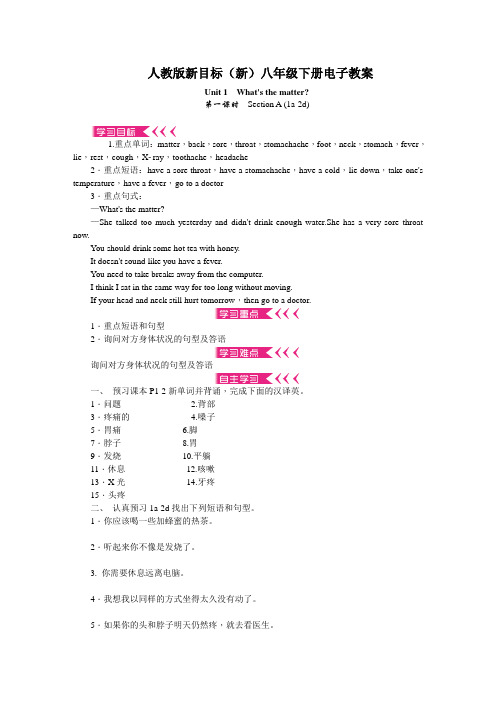
人教版新目标(新)八年级下册电子教案Unit 1What's the matter?第一课时Section A (1a-2d)1.重点单词:matter,back,sore,throat,stomachache,foot,neck,stomach,fever,lie,rest,cough,Xray,toothache,headache2.重点短语:have a sore throat,have a stomachache,have a cold,lie down,take one's temperature,have a fever,go to a doctor3.重点句式:—What's the matter?—She talked too much yesterday and didn't drink enough water.She has a very sore throat now.You should drink some hot tea with honey.It doesn't sound like you have a fever.You need to take breaks away from the computer.I think I sat in the same way for too long without moving.If your head and neck still hurt tomorrow,then go to a doctor.1.重点短语和句型2.询问对方身体状况的句型及答语询问对方身体状况的句型及答语一、预习课本P1-2新单词并背诵,完成下面的汉译英。
1.问题____________ 2.背部____________3.疼痛的____________ 4.嗓子____________5.胃痛____________ 6.脚____________7.脖子____________ 8.胃____________9.发烧____________ 10.平躺____________11.休息____________ 12.咳嗽____________13.X光____________ 14.牙疼____________15.头疼____________二、认真预习1a-2d找出下列短语和句型。
八级英语下册UnitWhat'sthematter全单元教案新版人教新目标版

Unit 1 What's the matter年级八学科英语课型新授课时间主备人八年级英语组教学课题Unit 1 What’s the matter?Section A (1a~2d)课时 1教学目标1. 学习用英语表达身体各部位的名称及如何谈论身体健康状况。
2. 培养学生能运用所学语言简单地描述自己的健康状况及如何询问对方的身体健康状况。
3. 通过学习课文内容,养成健康的生活方式。
4. 教育学生学会关心他人,通过询问他人的健康情况并能给予帮助,增进人与人之间的感情。
重点难点教学重点:1.掌握情态动词should / shouldn’t.的用法.2.学习have的用法.教学难点:学会提供帮助的基本句型教学准备PPT教学过程1、新课导入:Step1: Can you name the parts of the body?让学生用英语所处器官名称。
Step2:Follow me:(让学生站起来完成韵律操)Everybody moves your bodyNod your head and touch your faceTouch your nose and close your eyesTouch your ears and clap your handsRaise your arms and look at your backTouch your stomach and tap your footSit down and move your legs2、设问导读:二次备课4. 如果你的头和脖子明天仍然疼的话,请去看医生。
五.拓展探究Homework: Make up a conversation between a doctor and a patient.课堂小结本课通过身体器官韵律操导入课时内容,激发学生的学习兴趣,提高课堂教学的效率,同时针对学生日常生活中的常见症状,让学生在列举过程中掌握患病方式的三种表达方式。
(完整版)初中英语人教版八年级下册英语教学设计

(完整版)初中英语人教版八年级下册英语教学设计《I'll help to clean up the city parks》PPT课件【学习目标】1、知识与能力:(1)认知并熟练运用本课时重要单词和词组;Cheer volunteer sign notice lonely Clean up cheer up give out come up with put offhand out call up used to do care for(2)掌握并会运用could 用法could是情态动词,无人称和数的变化,后接动词原形。
句中could 用于提出建议比can 语气更为委婉,could 用于有礼貌地向对方提出要求或请求。
(3)掌握并灵活应用以下交际用语:I hope to do……I ‘d like to do.. I want to do..We need to do….We can’t do..We could do…Let’s do..2、过程与方法:学生自主预习,教师主导,小组交流,合作探究3、情感态度价值观:倡导人们互相帮助热爱生活。
【学习重点】:(1)动词不定式用法 (2) 情态动词could的用法(3)动副词组的用法... ... ...clean up 打扫;清除“动词+副词构成,加宾语的特点是:名词宾语,副词前后都可以,代词宾语,见到副词向前提。
(代词放中间)类似的短语:write down, turn on/off/up/down, cut up, give up(放弃)等call up(给….打电话) ,put up(张贴,搭建) hand out(分发) put off, ……Eg: ——Jane, your bedroom is so dirty.——Sorry, I’ll _____.A. clean up itB. clean it upC. clean them upClean-up名词, “扫除”。
新人教版八年级英语下册Unit1(1)教案

新人教版八年级英语下册Unit1(1)教案In this lesson。
we will be learning about health problems and how to give advice。
Our language goals are to learn vocabulary related to health problems and how to give advice based on someone's health issues。
Our skill goals are to be able to understand dialogues about health problems。
give advice based on someone's health issues。
and write key words and sentences related to health problems。
Our values goal is to cultivate students' empathy towards others' health and to promote a spirit of mutual help during emergencies.We will be focusing on phrases such as "have a stomachache," "have a cold," "lie down," "take one's temperature," "go to a doctor," "get off," "to one's surprise," "agree to do sth," "get into trouble," "fall down," "be used to," "run out (of)," "cut off," "get out of," "be in control of," "keep on (doing sth.)," and "give up." We will also be practicing sentences such as "What's the matter?" and "I have a stomachache。
新人教版八年级英语下册教案(全册全英文)

新人教版八年级英语下册教案(全册全英文)新人教版八年级英语下册教案(全册全英文)Unit 1 Will people have robots ?Teaching goals:1.Words&phrases: robot, paper, less, fewer, simple, unpleasant, factory, seem, etc .2.will 构成的一般将来时态的陈述句、否定句、疑问句及回答.3.There be 句型的一般将来时.4.more , less , fewer 的用法.5.学习一般将来时态的相关知识,学会对未来进行预测.6.对five years ago ,today ,in five years 简洁回顾与展望的方式,贴近实际符合学生心理,激发学习兴趣.7.通过时间对比复习一般过去时态、一般现在时态,巩固一般将来时. Important and difficult points :1.will构成一般将来时态的句式。
2.There be 句型的一般将来时态。
3.more , fewer , less 的用法。
4.How to make predictions .Period 1Teaching procedures:Step 1 Leading in1.Greetings: Welcome to school .What’s the date today ? Who’s on duty today ?Do you enjoy your winter holiday ?Do you finish your homework ?Do you want to live on the moon ?Can you guess what will happen in ten years ?Collect the Ss’ ans wers and say something about theirpredictions .Step 2 Pre-taskSB Page 2 ,1a .1.Look at the picture :How will the world be different in the future ,100 years fromnow ?We’re going to talk about sth in 100 years .2.Read each predictions to the class .Explain the new vocabulary .3.Read the instructions .Make sure Ss know what they should do .4.Do it by themselves .5.Talk about the answers with the class .Explain :一般将来时态构成: will / be going to +动词原形Step 3 While-taskSB Page 2 ,1b .1.Practise reading the six predictions .2.Read the instructions to Ss .Circle the things you hear on the recording .3.Play the tape twice .4.Play the tape a third time .At the same time ,check the answers .SB Page 2 , 1c .1.Pay attention to the dialogues .2.Read the dialogues fluently .3.Pairwork .Work in pairs to make predictions according to the sample .4.Ask several pairs to share their conversations to the class .SB Page 3 , 2a & 2b .1.Read the predictions .2.Read the instructions and point out the sample answer .3.Play the tape twice .Ss circle the word they hear in each sentences: more , less ,fewer .4.Check the answers .学生探究: less , fewer 的区别。
人教版八年级下册英语教案道客巴巴
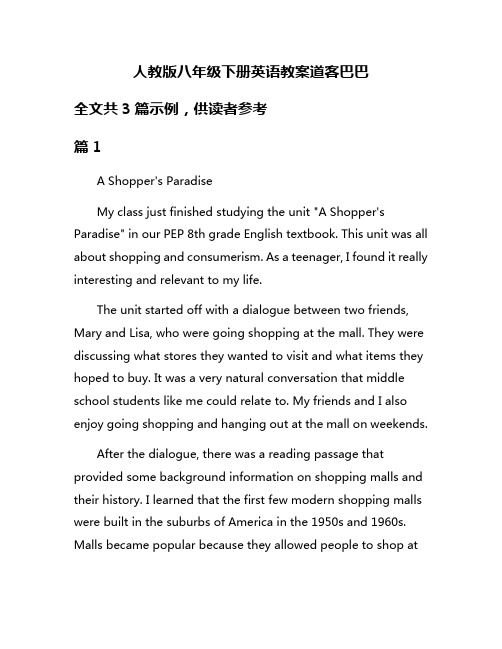
人教版八年级下册英语教案道客巴巴全文共3篇示例,供读者参考篇1A Shopper's ParadiseMy class just finished studying the unit "A Shopper's Paradise" in our PEP 8th grade English textbook. This unit was all about shopping and consumerism. As a teenager, I found it really interesting and relevant to my life.The unit started off with a dialogue between two friends, Mary and Lisa, who were going shopping at the mall. They were discussing what stores they wanted to visit and what items they hoped to buy. It was a very natural conversation that middle school students like me could relate to. My friends and I also enjoy going shopping and hanging out at the mall on weekends.After the dialogue, there was a reading passage that provided some background information on shopping malls and their history. I learned that the first few modern shopping malls were built in the suburbs of America in the 1950s and 1960s. Malls became popular because they allowed people to shop atmany different stores under one roof. They were protected from the weather and had amenities like food courts.As the reading passage described, malls offered a variety of shops selling clothes, shoes, accessories, electronics, sporting goods, books, toys, and more. Huge department stores often anchored the malls at either end. Walking through a big mall, you could find everything you needed all in one place. No wonder they were called "shoppers' paradises"!The passage also discussed some of the criticism around malls and excessive consumerism. It mentioned issues like traffic congestion, pollution from cars, destroying natural habitats to build malls, and encouraging people to spend beyond their means. However, it presented both sides in a balanced way.After reading and discussing the background information, we practiced various language skills related to shopping and spending money. This included lots of new vocabulary words like "bargain," "clearance," "splurge," "impulse buy," "window shopping," and more. We learned how to ask about prices, negotiating, and politely make requests at stores.There were also grammatical exercises on topics like forming plurals for different categories of merchandise. For example, we had to distinguish between singular and plural forms like "a pairof jeans" versus "two pairs of jeans." It was tricky but good practice.My favorite part was the role-play activities where we got to act out being shoppers and clerks at different types of stores. Getting into character and using the newly learnedwords/phrases made it much more engaging than just doing bookwork. I played the part of a sales associate at a clothing boutique trying to convince my friend to buy an overpriced handbag. It was fun!The unit culminated with a writing assignment where we had to describe our dream shopping mall and analyze the pros and cons of malls. I enjoyed flexing my creativity and argumentative skills for this essay. I designed my fantasy mall to have cool tech features like hologram assistants to help guide shoppers. But I also acknowledged some of the environmental downsides.Overall, I felt this was one of the most useful, practical units we've studied so far. As teenagers, my classmates and I are starting to shop independently and make decisions on how to spend our money. The skills we learned about budgeting, discounts, returns/exchanges, and responsible consumption will definitely come in handy. While it's fun to go on shoppingsplurges sometimes, this unit taught me the importance of being a smart, conscientious consumer.篇2The Guest is GodHave you ever heard the famous saying "The guest is God"? It's an Indian proverb that means you should treat your guests with the utmost respect and hospitality. This proverb is the central theme of the lesson "道客巴巴(The Guest is God)" in our 8th grade English textbook.The story is set in a small Indian village and follows a poor farmer named Sudama who used to be a childhood friend of Lord Krishna. Despite his humble circumstances, Sudama decides to visit the wealthy Lord Krishna who now lives in a grand palace. His wife is skeptical about the idea, questioning what kind of gift they could possibly bring that would be worthy of a king. But Sudama insists that the most valuable thing is the love and affection between old friends.With just a few handfuls of rice as a token gift, wrapped in an old cloth, Sudama sets off on the long journey to Krishna's palace. When he arrives, the guards initially turn him away, mocking his simple appearance. But Lord Krishna immediatelyrecognizes his childhood friend and rushes out to greet him with great joy and affection.Krishna embraces the poor Sudama warmly and ushers him inside with honor. Despite Sudama's embarrassment over his humble gift, Krishna accepts it as if it were the most precious offering. He treats his old friend as an honored guest, seating him comfortably and personally serving him delicious food and refreshments.As their reunion continues, Sudama starts to feelself-conscious about his poverty compared to Krishna's immense wealth and power as a king. But Krishna sees into his heart and reminds him that true friendship is beyond any materialistic concerns. Their bond is strong because it was formed in their innocent childhood days through sincere care and love for each other.In the end, when it is time for Sudama to depart, Krishna overwhelms him with abundant riches and treasures as a farewell gift. Sudama is reluctant to accept such valuable items, but Krishna insists, saying that he cherishes their friendship far more than any worldly riches. He asks only that Sudama returns home in peace and continues to regard him as a true friend for life.The story of the unshakable friendship between Lord Krishna and the humble Sudama drives home the moral of showing utmost respect, generosity and kindness to one's guests, no matter their social status. It teaches that the purest love stems from the depths of the human heart, not from materialistic considerations.From this lesson, I have learned the great significance of the Indian cultural value summed up in "The Guest is God." Even someone as powerful and wealthy as Lord Krishna honored his childhood friend Sudama and treated him as an esteemed guest deserving of the highest hospitality and warmth.The story has inspired me to be more welcoming, kind and generous towards any guests who may visit my home, regardless of their background or social standing. Like Krishna, I will aim to look beyond the surface and connect with the human essence of each guest through an open heart and sincere gestures of friendship.At the same time, I have also realized the reciprocal importance of being a gracious and humble guest myself when visiting others. Just as Sudama did not expect any grand reception despite Krishna's immense wealth, I too should not judge my hosts solely based on material factors. Instead, I shouldcherish the warmth of their hospitality and focus on upholding the human bonds of care and affection.The Indian ethos of "Atithi Devo Bhava" or "The Guest is God" is a profound philosophy that can help create a more compassionate and respectful world. By transcending superficial differences and nurturing the core human values of friendship, kindness and hospitality, we can strengthen the bonds that unite all people across all backgrounds and identities.In today's fast-paced world with its fair share of conflicts and divisions, this ancient wisdom of reverence for guests serves as a timeless reminder. It inspires us to slow down, disconnect from material pursuits, and reconnect with the inherent dignity and divinity within every human soul that arrives at our doorstep. I am grateful to have learned this lesson at a young age through our English textbook stories.篇3Dockaberra - An Imaginary World of WonderHey guys! Today I want to share my thoughts on the awesome lesson we just did in English class called "Dockaberra".I have to say, this was hands down one of the most fun andimaginative units we've covered so far this year. Let me tell you all about the wild and wacky world of Dockaberra!So Dockaberra is this make-believe place that our textbook describes. From what I understand, it's meant to be like a utopian society where everything is perfect and everyone is happy. The name "Dockaberra" itself is kind of a play on words combining "dock" (since it's an island) and "Canberra" which is the capital of Australia. Clever, right?The place is depicted as a remote island out in the middle of the ocean, untouched by the modern world. There are no factories or pollution, just pure natural beauty. The islanders live really simple lives as farmers and fishermen, growing their own crops and catching fish from the crystal blue waters. It's supposed to be like a paradise on Earth!One of the coolest things about Dockaberra is the way they make decisions. Instead of having one ruler or leader calling all the shots, they practice true democracy. Everyone has an equal say and they vote on every single decision that affects the community - how awesome is that? No parents, teachers or bosses telling you what to do, haha!From what the book describes, the islanders only work a few hours per day, with the rest of their time devoted to leisureactivities, sports, and cultural events. They have art festivals, music performances, athletic competitions - it sounds like an absolute blast. Sign me up to move there!Honestly though, my favorite part has to be their bizarre traditions and customs. For example, Dockaberra has this "Courtesy Custom" where you're supposed to mix up parts of common polite phrases. So instead of saying "Thank you very much" you'd say "Much thanks a lot". Or "Very nice to meet you" becomes "Meet you very nice". So weird but kind of hilarious!Then there's the whole concept of "Ramon Lists". Basically, the islanders make lists for every possible scenario or life event you can imagine. Need to pack for a trip? Consult the Ramon List on what to bring. Want to learn proper party etiquette? There's a Ramon List for that too. From the mundane to the extraordinary, they've got it all covered in list form!I could honestly go on and on about the quirky rituals and daily routines described in this lesson. The。
人教版英语初二下册的教学设计(通用10篇)

英语初二下册的教学设计人教版英语初二下册的教学设计(通用10篇)作为一名教学工作者,有必要进行细致的教学设计准备工作,借助教学设计可以更大幅度地提高学生各方面的能力,从而使学生获得良好的发展。
那么问题来了,教学设计应该怎么写?下面是小编为大家收集的人教版英语初二下册的教学设计,希望对大家有所帮助。
英语初二下册的教学设计篇1一、 Teaching Time:Date:Lesson Time:二、Teaching aims and demands:(一)1、 Four skills:month,January,February,March,April。
2、 Three skills:January is the first month of the year。
3、Lets make and talk制作相册。
要求用以下句式进行交流:It’s January、She is skating、In March,the children plant trees。
4、 Lets read and chant。
(二)Teaching Affection1、To promote Ss’ interest and confidence。
2、T o teach the Ss how to say the first month to fourth month of the year。
三、Teaching important points and difficult points:1、 Words:month,January,February,March,April。
2、 Sentence:January is the first month of the year。
四、Teaching methods:1、 Communication Teaching Method。
2、 Direct Teaching Method。
初中八年级英语下册人教版教案免费
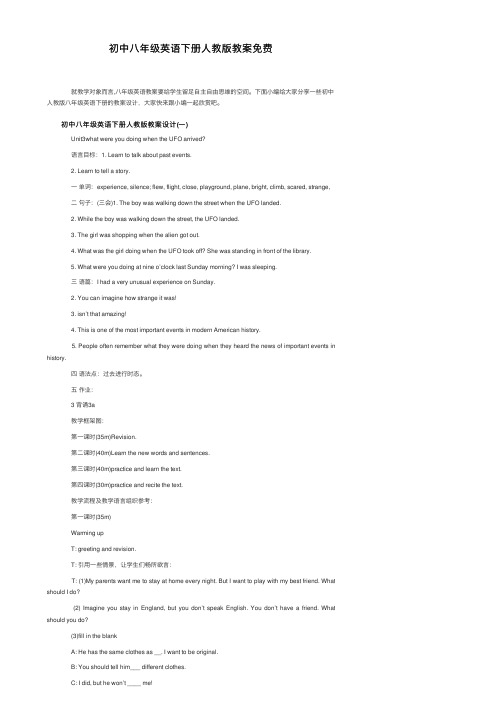
初中⼋年级英语下册⼈教版教案免费 就教学对象⽽⾔,⼋年级英语教案要给学⽣留⾜⾃主⾃由思维的空间。
下⾯⼩编给⼤家分享⼀些初中⼈教版⼋年级英语下册的教案设计,⼤家快来跟⼩编⼀起欣赏吧。
初中⼋年级英语下册⼈教版教案设计(⼀) Unit3what were you doing when the UFO arrived? 语⾔⽬标:1. Learn to talk about past events. 2. Learn to tell a story. ⼀单词:experience, silence; flew, flight, close, playground, plane, bright, climb, scared, strange, ⼆句⼦:(三会)1. The boy was walking down the street when the UFO landed. 2. While the boy was walking down the street, the UFO landed. 3. The girl was shopping when the alien got out. 4. What was the girl doing when the UFO took off? She was standing in front of the library. 5. What were you doing at nine o’clock last Sunday morning? I was sleeping. 三语篇:I had a very unusual experience on Sunday. 2. You can imagine how strange it was! 3. isn’t that amazing! 4. This is one of the most important events in modern American history. 5. People often remember what they were doing when they heard the news of important events in history. 四语法点:过去进⾏时态。
人教版八年级英语下册Unit1What’sthematter单元全部优秀教学案例

一、案例背景
人教版八年级英语下册Unit1 "What's the matter"主要围绕询问病痛和提供帮助展开,通过学习本单元,学生能够掌握基本的交际用语,询问他人的不适并给出适当的建议。此外,本单元还涉及到日常生活中的礼貌用语和表达关心他人的方式。
3.鼓励学生运用本节课所学句型和词汇进行交流,关注语言的准确性和流畅性。
4.各小组派代表进行表演,其他小组成员观摩并给予评价。
(四)总结归纳
1.教师引导学生回顾本节课所学内容,总结询问病痛和提供帮助的常用句型和词汇。
2.强调在日常交际中,如何用英语表达关心他人和礼貌用语。
3.提醒学生注意身体保健,养成良好的生活习惯,预防疾病。
五、案例亮点
1.情境教学法的运用:通过展示漫画、播放视频等情境,让学生在真实的语境中感知、理解和运用本单元所学内容。这种教学方法有助于提高学生的学习兴趣,增强他们的实际交际能力。
2.任务型教学法的运用:通过设计各种任务,如编写对话、角色扮演等,让学生在实际操作中运用所学知识,提高团队合作和沟通能力。这种教学方法有助于培养学生的实践能力和综合素质。
(二)问题导向
1.设计有针对性的问题,引导学生思考和探讨,如:“当你生病时,你会怎么做?”“你认为如何关心他人的健康?”等。
2.通过问题驱动,激发学生的好奇心,培养学生独立思考和解决问题的能力。
3.引导学生运用所学知识解决实际问题,如:“如果你的朋友生病了,你应该如何安慰他?”
4.鼓励学生提问,培养他们主动参与课堂、积极表达自己的观点的习惯。
3.教授日常英语交际中常用的表达关心和礼貌用语,如:“How are you?”、“Are you all right?”等。
新人教版八年级下册初中英语全册教案(教学设计)
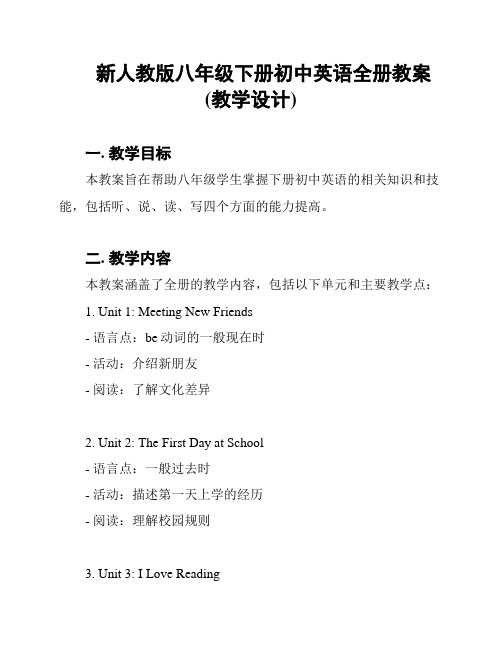
新人教版八年级下册初中英语全册教案(教学设计)一. 教学目标本教案旨在帮助八年级学生掌握下册初中英语的相关知识和技能,包括听、说、读、写四个方面的能力提高。
二. 教学内容本教案涵盖了全册的教学内容,包括以下单元和主要教学点:1. Unit 1: Meeting New Friends- 语言点:be动词的一般现在时- 活动:介绍新朋友- 阅读:了解文化差异2. Unit 2: The First Day at School- 语言点:一般过去时- 活动:描述第一天上学的经历- 阅读:理解校园规则3. Unit 3: I Love Reading- 语言点:情态动词can和must - 活动:介绍喜欢的书籍- 阅读:阅读理解4. Unit 4: My School Life- 语言点:形容词比较级和最高级- 活动:描述学校生活的不同方面- 阅读:了解不同的学校生活5. Unit 5: Our Future Jobs- 语言点:职业相关词汇- 活动:谈论未来的职业- 阅读:了解不同的职业6. Unit 6: Weather and Climate- 语言点:天气相关词汇和短语- 活动:讨论天气和气候- 阅读:了解不同地区的气候7. Unit 7: Enjoy Your Trip- 语言点:旅行相关词汇和短语- 活动:计划和描述旅行- 阅读:阅读旅行指南8. Unit 8: At the Farm- 语言点:动词的现在进行时- 活动:描述在农场的经历- 阅读:了解农场生活三. 教学方法本教案使用多种教学方法,包括但不限于:听力练、口语对话、阅读理解、小组讨论、写作练等。
教师将根据具体情况选择合适的教学方法进行教学。
四. 教学步骤1. 引入新课,激发学生兴趣。
2. 执行听力练以提高学生听力能力。
3. 进行口语对话练,帮助学生提高口语表达能力。
4. 进行阅读理解练,加深学生对课文的理解。
5. 进行小组讨论,让学生互相交流观点。
人教版八年级下册英语教案(全册)
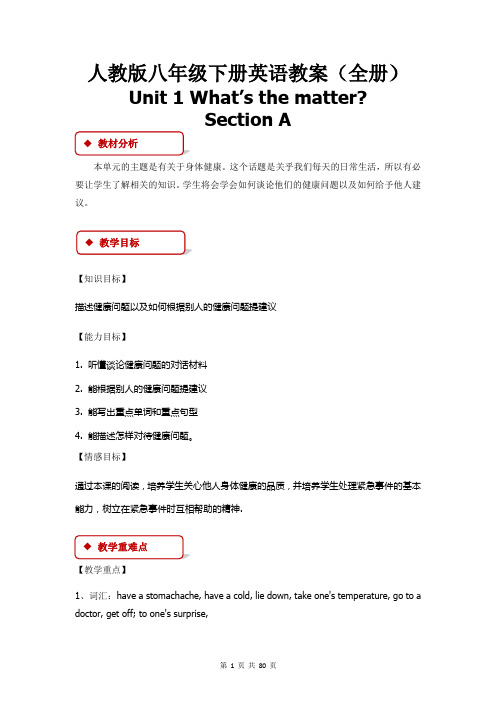
人教版八年级下册英语教案(全册)Unit 1 What’s the matter?Section A◆教材分析本单元的主题是有关于身体健康。
这个话题是关乎我们每天的日常生活,所以有必要让学生了解相关的知识。
学生将会学会如何谈论他们的健康问题以及如何给予他人建议。
◆教学目标【知识目标】描述健康问题以及如何根据别人的健康问题提建议【能力目标】1.听懂谈论健康问题的对话材料2.能根据别人的健康问题提建议3.能写出重点单词和重点句型4.能描述怎样对待健康问题。
【情感目标】通过本课的阅读,培养学生关心他人身体健康的品质,并培养学生处理紧急事件的基本能力,树立在紧急事件时互相帮助的精神.◆教学重难点◆【教学重点】1、词汇:have a stomachache, have a cold, lie down, take one's temperature, go to a doctor, get off; to one's surprise,2、句型:1. ——What's the matter?——I have a stomachache. You shouldn't eat so much next time.2 . ——What's the matter with Ben?——He hurt himself. He has a sore back.——He should lie down and rest.【教学难点】掌握情态动词should shouldn't.的用法;学习have的用法◆课前准备◆Multimedia, group work, cooperative discussion.◆教学过程Step1. Warm up1. Look at the picture and learn the parts of the body.2. New words and phrases.Step 2 Presentation1. 1aLook at the picture. Write the correct letter [a-m] for each part of the body. Then check the answers.2. 1bFirst, lead Ss to read the five names.Then look at the picture. Number the names 1-5.Finally, check the answers.3. 1cDivide two Ss into a pair to make conversations. Finally, invite several pairs to act out for the class.Step 3 Practice1. 2aTell Ss there are five conversations. In each conversation the person says what’s going on with them. Listen carefully and number the pictures.Play the tape. Then check the answers.2. 2bAsk Ss to listen to the recording again to match the problems with the advice.Play the recording again. Then check the answers.3. 2cAsk Ss to make conversations using the information in 2a and2b. Give them enough time to do this task. Later, invite several pairs to present their conversations to the class.Step 4 Consolidation1. 2dFirst, ask Ss to have a fast reading of the conversation to get the main idea.Then, lead Ss to read the conversation sentence by sentence, explain some language points.Finally, divide Ss into pairs to practice role-playing the conversation.2. 3aFirst, read the passage quickly and answer the question.Then, lead Ss to read the passage and analyse the key points.Finally, read together.3. 3bRead the passage again and check the things that happened in the story3cDiscuss the questions with a partner.4. Grammar focusFirst, lead Ss to read the sentences.Then, prompt Ss to analyse the use of model verb should.After that, explain the grammar together.5. 4aAsk Ss to fill in the blanks.Then , invite some Ss to present their answers.6. 4bAsk Ss to circle the best advice for these health problems, then add their own advice.After that, invite some Ss to present their advice.7. 4cOne student mimes a problem. The other students in your group guess the problem and give advice.Step 5 Language pointsStep 6 HomeworkMake a conversation about health problems and giving advice.Unit 1 What’s the matter?Section B◆教材分析本单元的主题是有关于身体健康。
新人教版八年级下册英语教案(全册)
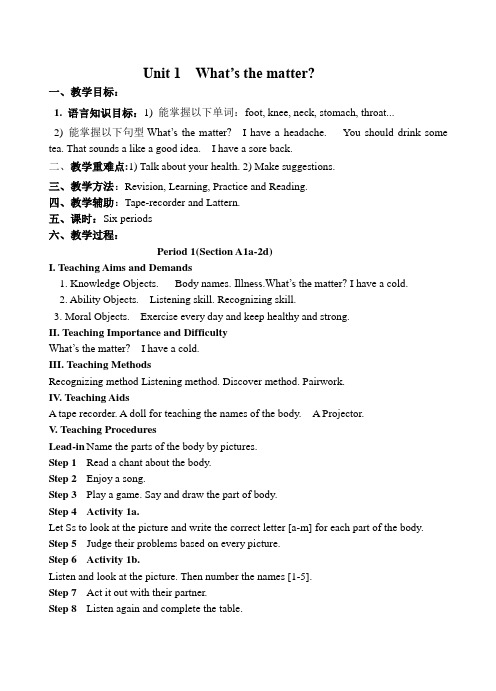
Unit 1 What’s the matter?一、教学目标:1. 语言知识目标:1) 能掌握以下单词:foot, knee, neck, stomach, throat...2) 能掌握以下句型What’s the matter?I have a headache. You should drink some tea. That sounds a like a good idea. I have a sore back.二、教学重难点:1) Talk about your health. 2) Make suggestions.三、教学方法:Revision, Learning, Practice and Reading.四、教学辅助:Tape-recorder and Lattern.五、课时:Six periods六、教学过程:Period 1(Section A1a-2d)I. Teaching Aims and Demands1. Knowledge Objects. Body names. Illness.What’s the matter? I have a cold.2. Ability Objects. Listening skill. Recognizing skill.3. Moral Objects. Exercise every day and keep healthy and strong.II. Teaching Importance and DifficultyWhat’s the matter?I have a cold.III. Teaching MethodsRecognizing method Listening method. Discover method. Pairwork.IV. Teaching AidsA tape recorder. A doll for teaching the names of the body. A Projector.V. Teaching ProceduresLead-in Name the parts of the body by pictures.Step 1 Read a chant about the body.Step 2 Enjoy a song.Step 3 Play a game. Say and draw the part of body.Step 4 Activity 1a.Let Ss to look at the picture and write the correct letter [a-m] for each part of the body. Step 5 Judge their problems based on every picture.Step 6 Activity 1b.Listen and look at the picture. Then number the names [1-5].Step 7 Act it out with their partner.Step 8 Listen again and complete the table.Step 9 Activity 1c. Pair works.Make conversations according to pictures.Step 10 Think how to give advice if somebody is ill and give examples by using pictures. Step 11 Activity 2a.Let Ss to listen and number the pictures [1-5] in the order they hear them.Step 12 Activity 2b.Listen again and match the problems with the advice.Step 13 Activity 2c.Make conversations using the information in 2a and 2b.Step 14 Activity 2d.Role-play the conversation.Step 15 Language points: explain the key words and phrases in section A-1. Homework:Teaching thought:Period 2(Section A 3a-3c)I. Teaching Aims and Demands1. Knowledge Objects New words. Some advice. Grammar Focus.2. Ability ObjectsListening skill. Reading skill.Writing municative competence.3. Moral Object To be a doctor and serve the people heart and soul.II. Teaching Importance and DifficultyWhat’s the matter? I have a toothache.Maybe you should see a dentist. That’s a good idea.III. Teaching Methods Listening method. Reading and writing methods. Pair-work. IV. Teaching Aids A tape recorder A projector.V. Teaching ProceduresLead-in Review some usual disease by pictures.Step 1 Talk about advice about health.Step 2 Learn some new words.Step 3 Discussion. Look at the title and the picture. Work in pairs and discuss some questions.Step 4 Activity 3a. Read the passage. Discuss where it comes from.Step 5 Give some reading strategies simply.Step 6 Read the passage and do true or false.Step 7 Activity 3b.Ask Ss to read the passage again and check (√) the things that happened in the story.Step 8 Free talk.If you see someone lying on the street, what should you do?.Step 9 Respect the aged and care for the young. It is a fine tradition of the Chinese nation. Teach the spirit to Ss.Step 10 Activity 3c. Discuss the questions with a partner.Step 11 Language points: explain the key words and phrases in section A-2.Step 12 More exercises about the language points.Homework:Teaching thought:Period 3(Grammar Focus-4c)I. Teaching Aims and Demands1. Knowledge Objects Reading and writing materials. Oral Practice.2. Ability Objects Reading skill. Writhing skill. Communicative competence.3. Moral Object Give good advice when someone needs your help.II. Teaching Importance and Difficulty Reading practice. Oral practice.III. Teaching Methods Reading and writing methods. Pair-work. Group-work.IV. Teaching Aids Workbook exercises.V. Teaching ProcedureLead-in Role - play a conversation between a patient and a doctor.Step 1 List some health problems and give some advice.Step 2Explanation about the use of modal verb should.Step 3 Do some basic exercise.Step 4Compare some other modal verbs.Step 5Do more exercise.Step 6Complete activity 4a and 4b.Step 7Work in groups. Discuss how to keep ourselves healthy.Step 8Complete activity 4c.Step 9Do exercise to review the structures of this unit.Homework Finish off the exercises of workbook.Teaching thought:Period 4(Section B 1a-1d)I. Teaching Aims and Demands1. Knowledge Objects Key vocabulary. Reading practice. Oral practice.2. Ability ObjectsListening skill. Reading skill. Writhing skill.Practice municative competence.3. Moral Object Ask for help when you have problem.II. Teaching Importance and DifficultyKey vocabulary. Reading practice. Oral practice.III. Teaching MethodsReading and writing methods. Understanding method.Pair-work.Listening method.IV. Teaching Aids A tape recorder.V. Teaching ProceduresLead-in Free talk: When these accidents happen, what should you do?Step 1 Activity 1a. Put the actions in order.Step 2 Activity 1b. Listen to the school n urse. Check (√) the problems you hear.Step 3 Activity 1c. Listen again. Write the letter of each treatment next to the problems you checked in the chart above.Step 4 Free talk:1.What would you do in these situations?2. What could we do to prevent these accidents?Step 5Give advice when accidents happen.Step 6 Pair works. Let Ss make conversations.E.g.:A:Who came to your office today?B: First, a boy came in. He hurt himself in P.E. class.A: What happened?B: …Homework After class you can talk to an expert about a particular problem.For exaple, what should I do when I have problems with my little brother?Teaching thought:Period 5(Section B 2a-2e)I. Teaching Aims and Demands1. Knowledge Objects Key vocabulary.Reading material.Group work.2. Ability Objects Reading skill.Writhing municative competence.3. Moral Object Great Chinese culture.II. Teaching Importance and DifficultyKey vocabulary.Reading practice.Writing exercise.Group-work.III. Teaching Methods Reading and writing municative approach.IV. Teaching Aids A projector.V. Teaching ProceduresLead-in Learn some new words.Step 1 Free talk: What is the most important in our life?Step 2 Think about the question by giving pictures:What kin d of accident or problem can happen when you …?Step 3Think about some accidents and talk about some advice to protect them.Step 4 Activity 2a.Write the letter of each sport next to each accident or problem that can happen.Step 5 Discuss these questions in groups.Step 6 Activity 2b.Read the passage and underline the words you don’t know.Step 7 Activity 2c.Read the statements and circle True, False or Don’t know.Step 8 Activity 2d. Read the passage again and answer the questions.Step 9 Activity 2e.Put the sentences in the correct order.Step 10 Introduce the story of 127 Hours.Homework Write down the sentences about when you’re tired in your exercise book. Teaching thought:Period 6(Section B 3a-Self Check)I. Teaching Aims and Demands1. Knowledge Objects V ocabulary in this unit.Writing practice.Just for Fun.2. Ability Objects Reading skill.Writhing municative competence.3. Moral Object Give your help to who needs one.II. Teaching Importance and Difficulty V ocabulary in this unit.Writing practice.III. Teaching Methods Reading and writing methods.Self check method.IV. Teaching Aids A projector.V. Teaching ProceduresStep 1Enjoy a video: Between a Rock and a Hard Place.Step 2 Talk about a story about a person who once were “betwee n a rock and a hard place”.Step 3 Activity 3a:Imagine you are the school nurse and a student just had an accident or a health problem. Make notes about what he/she should and shouldn’t do.Step 4 Activity 3b:Write a conversation between the nurse and the student using the notes in 3a.Step 5 Do self – check.Step 6 Language points: explain the key words and phrases in section B-2.Step 7 More exercisers about the language points.Homework Finish off the workbook exercises.Teaching thought:Unit 2 I’ll help to clean up the city park.一、教学目标:1. 语言知识目标:1) 能掌握以下单词:clean up, city, cheer, cheer up, give out, volunteer, notice,...2) 能掌握以下句型:① You could help to clean up the city parks. ....3) 能了解以下语法:情态动词could, should的用法;用should或could提出建议并对别人的建议作出评价。
新版人教版八年级英语下册全册教案

新版人教版八年级英语下册全册教案Unit 1 What’s the matter?教学目标:1语言目标:描述健康问题的词汇,及如何根据别人的健康问题提建议。
2 技能目标:能听懂谈论健康问题的对话材料;能根据别人的健康问题提建议;能写出重点单词和重点句型,并能描述怎样对待健康问题。
3 情感目标:通过开展扮演病人等活动,培养学生关心他人身体健康的品质。
通过本课的阅读,培养学生处理紧急事件的基本能力,树立紧急事件时互相帮助的精神。
教学重点:短语: have a stomachache, have a cold, lie down, take one’s temperature,go to a doctor, get off, to one’s surprise, agree to do sth., get into trouble,fall down, be used to, run out (of), cut off , get out of, be in control of ,keep on (doing sth.), give up句子: 1 What’s the matter? I have a stomachache. You shouldn’t eat so much next time.2 What’s the matter with Ben?He hurt himself. He has a sore back.He should lie down and rest.3 Do you have a fever? Yes, I do. No, I don’t. I don’t know.4 Does he have a toothache? Yes, he does.He should see a dentist and get an X-ray.5 What should she do? She should take her temperature.6 Should I put some medicine on it? Yes, you should No, you shouldn’t.教学难点:掌握情态动词should \shouldn’t. 的用法;学习have的用法。
人教版八年级英语下册《Unit 1》教案
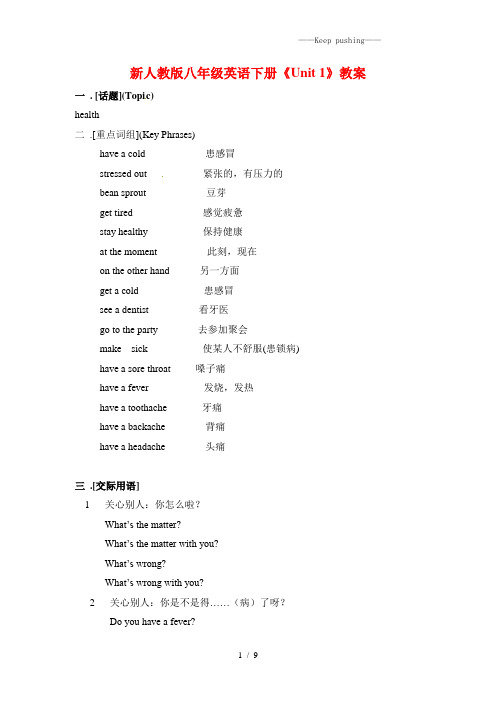
新人教版八年级英语下册《Unit 1》教案一. [话题](Topic)health二.[重点词组](Key Phrases)have a cold患感冒stressed out 紧张的,有压力的bean sprout豆芽get tired感觉疲惫stay healthy保持健康at the moment此刻,现在on the other hand另一方面get a cold患感冒see a dentist看牙医go to the party去参加聚会make sick使某人不舒服(患锁病)have a sore throat嗓子痛have a fever发烧,发热have a toothache牙痛have a backache背痛have a headache头痛三.[交际用语]1 关心别人:你怎么啦?What’s the matter?What’s the matter with you?What’s wrong?What’s wrong with you?2 关心别人:你是不是得……(病)了呀?Do you have a fever?Are you hungry?3 关心别人:你应该……,你最好……,为什么……?You should go to bed early.You shouldn’t eat anything for 24 hours.You’d better go to bed early.You’d better not eat anything for 24 hours.Why not go to bed early?Why don’t you go to bed early?4 关心自己:我不舒服,我病了,我饿了I’m not fe eling well.I have a headache.I am hungry.四. [重点难点释义](Language Points)1.What's the matter, Judy?朱迪,你哪里不舒服?(你怎么了?)matter n.问题,麻烦,事件,通常与介词“with”连用:What's the matter with him?他怎么了?这个句型可以与下面这两个句子互换:What's wrong with him?What's the trouble with him?wrong是形容词,前面没有“the”; matter和trouble都是名词,前面应有“the”, trouble前还可以用形容词性的物主代词。
人教版新目标英语八年级下册教案全册(共50份)

人教版新目标英语八年级下册教案全册(共50份)Unit 3 Could you clean up your room?Section B (1a~1e)教学目标【知识与技能】1. 掌握本单元单词并正确使用以下常用表达法:buy some drinks and snacks, borrow some money, invite sb. to the party, make your bed…2. 能熟练掌握并使用下列重点句式:—Could you clean your room? —Yes, I can. —Could I invite my friends to a party? —No, you can’t have the party•Unit 3 Could you clean up your room?Section B (2a~3b)教学目标【知识与技能】1. 学习并掌握新词汇:chore; waste, provide, depend, drop等。
2. 能正确使用以下常用表达:a waste of time, provide sth. for sb., mind doing sth., take care of, depend on等。
3. 学会使用以下句型:they don’t have time… they should spend time on… it’s not enough to…, the+比较级,•Unit 3 Could you clean up your room?Section B (self check)教学目标【知识与技能】1. 学习并掌握新词汇:fair, unfair等。
2. 能正确使用以下常用表达:do chores; it’s fair/unfair for sb. to do sth.3. 注意正确搭配下列重点句式:do, clean, make, fold, sweep, take out4. 能熟练掌握并使用下列重点句式:I think/believe/agree that…; Can I/you…?【情感、态度与价值观】让学生学会征求他人的许可,并学会有礼貌地请•Unit 3 Could you please clean your room?Section A(1a~2d)教学目标【知识与技能】1. 掌握重点词汇rubbish,fold,sweep, floor, mess, take out the rubbish, fold the clothes, sweep the floor, all the time, make the bed, go out for dinner2. 掌握以下句型: 1.—Could you please sweep the floor? —Yes,sure.2.—Co•Unit 3 Could you please clean your room?Section A(3a~4c)教学目标【知识与技能】1. 学习掌握下列词汇:throw, neither, shirt, pass, borrow, lend, finger, hate, while, throw down, take the dog for a walk, be angry with, all the time, as soon as2. 句型:① For one week, she did not do any housework and neither did I.②—Could I b。
新人教版八年级下册英语教案

新人教版八年级下册英语教案一份优秀的英语教案是八年级英语教师上好一堂课的保障。
下面是小编为大家精心整理的新人教版八年级下册英语的教案,仅供参考。
新人教版八年级下册英语教案(一)Section B 1a-2e教学目标一、知识与技能1. 掌握新单词和短语。
2. 在不同的情境中正确、熟练地使用表示委婉请求的句型。
3. 培养听、说、读、写四项基本技能。
二、过程与方法观看,感受,模仿,实践。
三、情感态度与价值观认识到不仅在家庭中,在生活中的其他情况我们也要积极参加,勇于实践。
教学重点在不同的情境中正确、熟练地使用表示委婉请求的句型。
教学难点培养听、说、读、写四项基本技能。
教法导航创设情境,实践演练。
学法导航通过听说读写,独立思考,小组合作完成学习任务,提高各项能力。
教学准备图片,多媒体。
新人教版八年级下册英语教案(二)教学过程Step 1 GreetingsGreet the students as usual.Step 2 PreparationT:When I was a teenager,my parents often asked me to clean my room. Sometimes they asked me to buy some things. Now I often ask my daughter to take out the trash. What chores do your parents usually ask you to do?S1:My mother usually asks me to buy some food.S2:My mother often asks me to make my bed.S3:My father always asks me to clean my bike.S4:They ask me to clean my bedroom.T: Do you ask your parents to do anything? What do you ask them to do?S1:I ask my mother to make bed for me.S2:I ask my father to buy some books for me....Step 3 PracticeT:Look at the items in 1a,Section B. What can teenagers ask their parents to do? Whatdo parents ask their teenagers to do? Write “parents” or “teenagers” next to each phrase.Ask students to go through the phrases first. Give some explanations about the key words.teenager:someone who is between 13 and 19 years oldsnack:something eaten between mealsborrow:borrow sth from sblend:lend sth to sb/lend sb sthinvite:invite sb to sth (a wedding,party,meal,etc.) ; invite sb to do sthThen check their answers.Step 4 Pair workLet students use the phrases in activity 1a to make conversations between parents and teenagers. First,get a pair of students to read the sample conversations. Then students make their own conversations.Step 5 Listening1c, T:Now listen to the conversation between Sandy and her mom. Please check each item in activity 1a they talk about. Put a check mark in front of each phrase you hear.Play the recording,students only listen.Play the recording a second time. Students listen and check the items.Check the answers with the whole class.1d, T:From the conversation,we know Sandy will hold a party. She will invite some friends to the party. But she needs to do some preparation. She asks her mom to help her. And Dave is one of Sandy’s friends. He will also help Sandy do the preparation. So what is Sandy’s mom going to do? What is Sandy going to do? What are Sandy and Dave going to do? Let’s listen again and fill in the chart in activity 1b.Play the recording a third time. Ask students to write down the things the three people are going to do. Pause the tape where necessary. Then check the answers.Step 6 Pair work1e T:Suppose you are having a party. Make a list of things you need to do. Some things are already given. Write more things you need to do. Get students work in pairs and add more things to the list. For example:buy some CDs,decorate the walls,make some gifts ...T:Now make conversations and ask your partner to do some of the things for you. Then ask some pairs to demonstratetheir conversations.Step 7 DiscussionSay:Doing chores has advantages and disadvantages. What’s your opinion? Ask some students to report their opinion. Then say:Suppose you are Ms. Miller or Mr. Smith,after reading the two letters,work in groups and discuss the advantages and disadvantages of doing chores. After a few minutes,ask some groups to report their opinions.Step 8 ReadingSay:Read the letters again and try to find out the phrases in 2d. Ask some students totranslate the phrases first and then ask them to work in pairs to write one sentence with each phrase from the letters. Then ask some students to report their sentences.Step 9 Homework1. Finish the chart in 2c according to Ms. Miller and Mr. Smith.2. Discuss the questions in 2e with a partner.新人教版八年级下册英语教案(三)课堂作业I. Match the sentences( )1. Could I speak to Sam,please?( )2. Would you like to come to my birthday party tonight?( )3. May I come in?( )4. What about going out for a walk?( )5. Shall I open the door?( )6. Will you (please) lend your pen to me?a. Good idea!b. Yes,please.c. Certainly. Hold on,please.d. I’d love to.e. Sorry,I’m afraid not.f. Come in,please.II. Translate the sentences into English.1. 你能接一下电话吗?______________________________________2. 你能把书带到教室里去吗?______________________________________3. 你能帮我打扫房间吗?______________________________________4. 我能打开窗户吗?______________________________________5. 我可以借你的车吗?______________________________________参考答案:I. c d f a b e II. 1. Could you answer the phone? 2. Could you take the book to the classroom? 3. Could you help me clean the room? 4. Could I open the window? 5. Could I borrow your car?教学反思教师在开展教学活动时,个别小组出现“冷清”的场面,这些学生只顾自己独立思考,停留在独立学习的层次上,没有发挥合作学习的优势,使合作流于形式。
- 1、下载文档前请自行甄别文档内容的完整性,平台不提供额外的编辑、内容补充、找答案等附加服务。
- 2、"仅部分预览"的文档,不可在线预览部分如存在完整性等问题,可反馈申请退款(可完整预览的文档不适用该条件!)。
- 3、如文档侵犯您的权益,请联系客服反馈,我们会尽快为您处理(人工客服工作时间:9:00-18:30)。
Unit 1 What’s the matter?一、教学目标:1. 语言知识目标:1) 能掌握以下单词:foot, knee, neck, stomach, throat...2) 能掌握以下句型What’s the matter?I have a headache. You should drink some tea. That sounds a like a good idea. I have a sore back.二、教学重难点:1) Talk about your health. 2) Make suggestions.三、教学方法:Revision, Learning, Practice and Reading.四、教学辅助:Tape-recorder and Lattern.五、课时:Six periods六、教学过程:Period 1(Section A1a-2d)I. Teaching Aims and Demands1. Knowledge Objects. Body names. Illness.What’s the matter? I have a cold.2. Ability Objects. Listening skill. Recognizing skill.3. Moral Objects. Exercise every day and keep healthy and strong.II. Teaching Importance and DifficultyWhat’s the matter?I have a cold.III. Teaching MethodsRecognizing method Listening method. Discover method. Pairwork.IV. Teaching AidsA tape recorder. A doll for teaching the names of the body. A Projector.V. Teaching ProceduresLead-in Name the parts of the body by pictures.Step 1 Read a chant about the body.Step 2 Enjoy a song.Step 3 Play a game. Say and draw the part of body.Step 4 Activity 1a.Let Ss to look at the picture and write the correct letter [a-m] for each part of the body. Step 5 Judge their problems based on every picture.Step 6 Activity 1b.Listen and look at the picture. Then number the names [1-5].Step 7 Act it out with their partner.Step 8 Listen again and complete the table.Step 9 Activity 1c. Pair works.Make conversations according to pictures.Step 10 Think how to give advice if somebody is ill and give examples by using pictures. Step 11 Activity 2a.Let Ss to listen and number the pictures [1-5] in the order they hear them.Step 12 Activity 2b.Listen again and match the problems with the advice.Step 13 Activity 2c.Make conversations using the information in 2a and 2b.Step 14 Activity 2d.Role-play the conversation.Step 15 Language points: explain the key words and phrases in section A-1. Homework:Teaching thought:Period 2(Section A 3a-3c)I. Teaching Aims and Demands1. Knowledge Objects New words. Some advice. Grammar Focus.2. Ability ObjectsListening skill. Reading skill.Writing municative competence.3. Moral Object To be a doctor and serve the people heart and soul.II. Teaching Importance and DifficultyWhat’s the matter? I have a toothache.Maybe you should see a dentist. That’s a good idea.III. Teaching Methods Listening method. Reading and writing methods. Pair-work. IV. Teaching Aids A tape recorder A projector.V. Teaching ProceduresLead-in Review some usual disease by pictures.Step 1 Talk about advice about health.Step 2 Learn some new words.Step 3 Discussion. Look at the title and the picture. Work in pairs and discuss some questions.Step 4 Activity 3a. Read the passage. Discuss where it comes from.Step 5 Give some reading strategies simply.Step 6 Read the passage and do true or false.Step 7 Activity 3b.Ask Ss to read the passage again and check (√) the things that happened in the story.Step 8 Free talk.If you see someone lying on the street, what should you do?.Step 9 Respect the aged and care for the young. It is a fine tradition of the Chinese nation. Teach the spirit to Ss.Step 10 Activity 3c. Discuss the questions with a partner.Step 11 Language points: explain the key words and phrases in section A-2.Step 12 More exercises about the language points.Homework:Teaching thought:Period 3(Grammar Focus-4c)I. Teaching Aims and Demands1. Knowledge Objects Reading and writing materials. Oral Practice.2. Ability Objects Reading skill. Writhing skill. Communicative competence.3. Moral Object Give good advice when someone needs your help.II. Teaching Importance and Difficulty Reading practice. Oral practice.III. Teaching Methods Reading and writing methods. Pair-work. Group-work.IV. Teaching Aids Workbook exercises.V. Teaching ProcedureLead-in Role - play a conversation between a patient and a doctor.Step 1 List some health problems and give some advice.Step 2Explanation about the use of modal verb should.Step 3 Do some basic exercise.Step 4Compare some other modal verbs.Step 5Do more exercise.Step 6Complete activity 4a and 4b.Step 7Work in groups. Discuss how to keep ourselves healthy.Step 8Complete activity 4c.Step 9Do exercise to review the structures of this unit.Homework Finish off the exercises of workbook.Teaching thought:Period 4(Section B 1a-1d)I. Teaching Aims and Demands1. Knowledge Objects Key vocabulary. Reading practice. Oral practice.2. Ability ObjectsListening skill. Reading skill. Writhing skill.Practice municative competence.3. Moral Object Ask for help when you have problem.II. Teaching Importance and DifficultyKey vocabulary. Reading practice. Oral practice.III. Teaching MethodsReading and writing methods. Understanding method.Pair-work.Listening method.IV. Teaching Aids A tape recorder.V. Teaching ProceduresLead-in Free talk: When these accidents happen, what should you do?Step 1 Activity 1a. Put the actions in order.Step 2 Activity 1b. Listen to the school n urse. Check (√) the problems you hear.Step 3 Activity 1c. Listen again. Write the letter of each treatment next to the problems you checked in the chart above.Step 4 Free talk:1.What would you do in these situations?2. What could we do to prevent these accidents?Step 5Give advice when accidents happen.Step 6 Pair works. Let Ss make conversations.E.g.:A:Who came to your office today?B: First, a boy came in. He hurt himself in P.E. class.A: What happened?B: …Homework After class you can talk to an expert about a particular problem.For exaple, what should I do when I have problems with my little brother?Teaching thought:Period 5(Section B 2a-2e)I. Teaching Aims and Demands1. Knowledge Objects Key vocabulary.Reading material.Group work.2. Ability Objects Reading skill.Writhing municative competence.3. Moral Object Great Chinese culture.II. Teaching Importance and DifficultyKey vocabulary.Reading practice.Writing exercise.Group-work.III. Teaching Methods Reading and writing municative approach.IV. Teaching Aids A projector.V. Teaching ProceduresLead-in Learn some new words.Step 1 Free talk: What is the most important in our life?Step 2 Think about the question by giving pictures:What kin d of accident or problem can happen when you …?Step 3Think about some accidents and talk about some advice to protect them.Step 4 Activity 2a.Write the letter of each sport next to each accident or problem that can happen.Step 5 Discuss these questions in groups.Step 6 Activity 2b.Read the passage and underline the words you don’t know.Step 7 Activity 2c.Read the statements and circle True, False or Don’t know.Step 8 Activity 2d. Read the passage again and answer the questions.Step 9 Activity 2e.Put the sentences in the correct order.Step 10 Introduce the story of 127 Hours.Homework Write down the sentences about when you’re tired in your exercise book. Teaching thought:Period 6(Section B 3a-Self Check)I. Teaching Aims and Demands1. Knowledge Objects V ocabulary in this unit.Writing practice.Just for Fun.2. Ability Objects Reading skill.Writhing municative competence.3. Moral Object Give your help to who needs one.II. Teaching Importance and Difficulty V ocabulary in this unit.Writing practice.III. Teaching Methods Reading and writing methods.Self check method.IV. Teaching Aids A projector.V. Teaching ProceduresStep 1Enjoy a video: Between a Rock and a Hard Place.Step 2 Talk about a story about a person who once were “betwee n a rock and a hard place”.Step 3 Activity 3a:Imagine you are the school nurse and a student just had an accident or a health problem. Make notes about what he/she should and shouldn’t do.Step 4 Activity 3b:Write a conversation between the nurse and the student using the notes in 3a.Step 5 Do self – check.Step 6 Language points: explain the key words and phrases in section B-2.Step 7 More exercisers about the language points.Homework Finish off the workbook exercises.Teaching thought:Unit 2 I’ll help to clean up the city park.一、教学目标:1. 语言知识目标:1) 能掌握以下单词:clean up, city, cheer, cheer up, give out, volunteer, notice,...2) 能掌握以下句型:① You could help to clean up the city parks. ....3) 能了解以下语法:情态动词could, should的用法;用should或could提出建议并对别人的建议作出评价。
